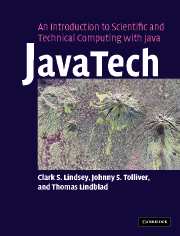JavaTech, an Introduction to Scientific and Technical Computing with Java
JavaTech is a practical introduction to the Java programming language with an emphasis on the features that benefit technical computing. After presenting the basics of object-oriented programming in Java, it examines introductory topics such as graphical interfaces and thread processes. It goes on to review network programming and develops Web client-server examples for tasks such as monitoring remote devices. The focus then shifts to distributed computing with RMI. Finally, it examines how Java programs can access the local platform and interact with hardware. Topics include combining native code with Java, communication via serial lines, and programming embedded processors. An extensive web site supports the book with additional instructional materials. JavaTech demonstrates the ease with which Java can be used to create powerful network applications and distributed computing applications. It will be used as a textbook for programming courses, and by researchers who need to learn Java for a particular task.
- Introduces Java Micro Edition and UML
- Focusses on practical ways that Java can aid technical computing, such as networking, graphical user interfaces and distributed applications
- Supported by extensive online web site, with instructional materials, applets and application codes - see www.cambridge.org/9780521821131
Product details
June 2010Paperback
9780521527972
732 pages
246 × 189 × 37 mm
1.29kg
Available
Table of Contents
- Preface
- Acknowledgements
- Part I. Introduction to Java:
- 1. Introduction
- 2. Language basics
- 3. Classes and objects in Java
- 4. More about objects in Java
- 5. Organizing Java files and other practicalities
- 6. Java graphics
- 7. Graphical user interfaces
- 8. Threads
- 9. Java input/output
- 10. Java utilities
- 11. Image handling and processing
- 12. More techniques and tips
- Part II. Java and the Network:
- 13. Java networking basics
- 14. A Java web server
- 15. Client/server with sockets
- 16. Distributed computing
- 17. Distributed computing - the client
- 18. Java remote method invocation (RMI)
- 19. CORBA
- 20. Distributed computing - putting it all together
- 21. Introduction to web services and XML
- Part III. Out of the Sandbox:
- 22. The Java native interface (JNI)
- 23. Accessing the platform
- 24. Embedded Java
- Appendices
- Index.






